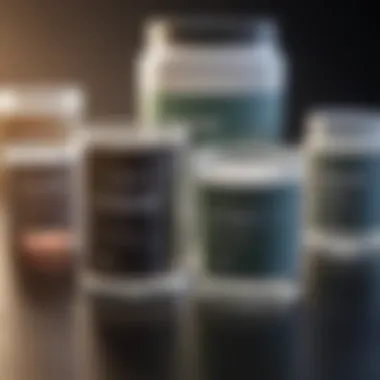Exploring the Multifaceted Roles of Primer


Intro
The concept of primer is not limited to a single field but spans various domains, notably in molecular biology, cosmetics, and painting. This article aims to articulate the significance and versatility of primer, revealing how it enhances performance in these areas. By examining its chemical composition and diverse functions, an informed understanding can emerge concerning this preparatory agent's role in both laboratory settings and everyday life.
Methodologies
Description of Research Techniques
In the realm of molecular biology, primer is crucial for processes such as the Polymerase Chain Reaction (PCR). During PCR, short sequences of nucleotides act as a starting point for DNA synthesis. The primers bind to the target DNA, facilitating the amplification of specific genetic material. The research techniques used in this context rely heavily on precision, as even slight variations in primer design can impact the overall efficiency of the reaction.
In cosmetics, primers prepare the skin for make-up application. This involves understanding the skin types and specific formulations that can address issues like oiliness or dryness. Companies often conduct focus groups and trials to gauge user responses, ensuring product efficacy.
In painting, primers prepare surfaces for better adhesion of paints. This involves evaluating different surfaces, such as wood, metal, or drywall, and applying primer that corresponds with the type of paint to be used. This methodological approach enhances the durability and finish of the final layer.
Tools and Technologies Used
Technological advancements have transformed how primers are applied in these disciplines. Tools like thermal cyclers in molecular biology provide controlled environments for PCR. In cosmetics, airbrushes or precision applicators help apply primers evenly across the skin. For painting, sprayers and brushes, designed with specific bristle types, enable effective primer application.
Understanding these tools is essential, as they contribute to the overall effectiveness of primers in various applications.
Discussion
Comparison with Previous Research
Research indicates that primers have evolved significantly in their formulations. Earlier studies focused primarily on basic adherence in painting applications, while contemporary research is exploring advanced chemical interactions that enhance aesthetic and functional qualities.
In molecular biology, the evolution of primers has led to greater specificity and sensitivity in genetic studies. This increases the potential for reliable results, which were not achievable with older methodologies.
Theoretical Implications
The implications of primer use cross various educational and research domains. Understanding the variations and properties of primers allows professionals to apply informed decision-making in their respective fields. This knowledge also invites further exploration into innovative uses and formulations that could enhance existing applications.
Primers serve as a bridge between different processes, from enhancing the effectiveness of genetic analysis to ensuring the desired finish in beauty products and home improvement endeavors.
"Primers represent a foundational tool across numerous applications; their role is vital in ensuring success in related processes."
Ultimately, the significance of primer in various applications rests not just on its existence but on its impact on efficiency, aesthetics, and functionality, connecting diverse areas of science and practical life.
Preface to Primer
The concept of primer is significant in various fields, including science and cosmetics. Understanding primer involves exploring its function and importance across multiple applications. For instance, in molecular biology, primers are essential in techniques like polymerase chain reaction (PCR). They act as starting points for DNA synthesis and play a critical role in amplifying genetic material. This function is not limited to science, as primers also serve important roles in makeup application and painting, where they prepare surfaces for subsequent layers.
In this section, we address the definition, historical context, and types of primers available in different applications. A well-rounded understanding equips the reader with insights into how primers can influence outcomes across varying practices.
Definition of Primer
A primer, in general terms, is a substance used to prepare a surface or a reaction for subsequent processes. In molecular biology, it refers to short strands of nucleotides which are complementary to the target DNA sequence. These primers are crucial for initiating DNA replication during PCR. Meanwhile, in the cosmetic industry, a primer is a base product that is applied before foundation to improve application and longevity of makeup. Similarly, in painting, primers ensure better adhesion of paint to surfaces, facilitating smoother finishes and enhancing durability. The specific role of primer varies with context but maintains a common goal: enhancing the performance of what follows.
Historical Context
The use of primers dates back to significant technological advancements and discoveries. In molecular biology, the importance of primers became clear with the advent of PCR in the 1980s. This technique allowed scientists to amplify specific DNA sequences with unprecedented precision and speed. The role of primers was thus solidified as a foundational component in genetic research, cloning, and diagnostics.
In cosmetic applications, makeup primers gained popularity in the early 2000s, with brands focusing on products that offered skin benefits while enhancing makeup performance. As for painting, the use of primers can be traced to ancient times, where artisans used various substances to prepare surfaces before applying pigments. Understanding this historical background provides a context for the evolving significance of primers across diverse fields.
Types of Primers


The types of primers vary widely between disciplines. In molecular biology, there are several categories, such as
- Universal primers that bind to multiple sequences
- Gene-specific primers tailored to amplify particular genes
- Degenerate primers that allow for variability in sequences due to mutations.
For cosmetics, makeup primers may be classified based on their specific functions:
- Matte finishes for oily skin
- Hydrating primers for dry skin
- Color-correcting primers to even out skin tone
In painting, primers can also be categorized according to formulations:
- Water-based primers, which are less volatile
- Oil-based primers, offering superior adhesion
- Shellac-based primers, good for sealing stains.
Understanding these classifications is crucial for selecting the appropriate primer depending on the desired application, ensuring optimal performance and results.
Primer in Molecular Biology
Primer plays a vital role in the realm of molecular biology. Their significance arises mainly from their functionality in various genetic techniques, particularly in the Polymerase Chain Reaction (PCR). This process is essential for amplifying DNA sequences, allowing for detailed analysis and study. The specificity and efficiency of these reactions predominantly rely on the properties of the primers used. Thus, an in-depth exploration of primers in molecular biology is not only relevant but pivotal for understanding modern genetic research and applications.
Role in Polymerase Chain Reaction (PCR)
The Polymerase Chain Reaction is a cornerstone technique used in molecular biology. Primers are short strands of DNA that are crucial for the initiation of DNA synthesis. In PCR, two primers flank the target DNA sequence, ensuring that the polymerase enzyme can synthesize new strands of DNA by starting from these primers.
Inadequately designed primers can lead to non-specific amplification or no amplification at all, which deeply affects the reliability of the results. Thus, the careful selection of primer sequences that are complementary to the target DNA is a critical step in protocol design. It is also important to consider the melting temperature of the primers, as this affects the binding efficiency during thermocycling.
Design Considerations for Primers
Designing effective primers demands careful attention to several factors. First, one should ensure that the primer length is optimal; typical lengths range from 18 to 25 nucleotides. This promotes specificity while maintaining sufficient stability during binding. The GC content is another crucial factor. Ideally, it should fall between 40% and 60% to balance the melting temperature and stability of the primer-DNA hybrid.
Moreover, avoiding secondary structures such as hairpins or dimers is essential to prevent complications during the PCR process. Tools such as Primer3 are commonly used to aid in primer design. Measurements that evaluate the efficiency of the primers can often be calculated through various online platforms.
Detection and Quantification Techniques
Accurate detection and quantification of PCR products depend largely on the primers used in the reaction. Methods like quantitative PCR (qPCR) utilize fluorescent dyes that bind to the DNA. Here, the efficiency of the primers reflects directly on the quantification accuracy. Using primers that offer high specificity not only enhances the yield of the desired product but also improves data reliability.
Different techniques, including SYBR Green or TaqMan assays, rely on primers exhibiting precise binding properties. Thus, optimizing primer design is crucial to achieving accurate results. As research in molecular biology moves forward, continuing improvements in primer technology will emerge, supporting more complex applications and enhancing the field's overall reliability.
"The effectiveness of PCR hinges on the precision with which primers are developed and utilized."
Understanding these elements is essential for students, researchers, and professionals engaged in molecular biology, as they navigate the complexities of genetic analysis. Adequate knowledge of primers aids these individuals in conducting experiments that yield reproducible and trustworthy findings.
Primer in Cosmetics
In the realm of cosmetics, primer serves as a foundational element that prepares the skin for makeup application. This section unpacks the significance of makeup primers, exploring their functionalities, impact on skin appearance, and the analysis of their key ingredients. Understanding these aspects is crucial for optimizing makeup performance and enhancing the overall aesthetic experience.
Functionality of Makeup Primer
Makeup primer is designed to create a smooth base for other makeup products. It acts as a barrier between the skin and makeup, mitigating issues that often arise from direct application. Primers can help to minimize the appearance of pores, fine lines, and rough skin texture. Additionally, they can enhance the longevity of makeup, keeping it intact throughout the day.
Different types of primers exist, each catering to various skin types and specific concerns. For example, mattifying primers are formulated for oily skin, while hydrating primers suit dry skin types. Some other formulations may contain optical diffusers, which help to blur imperfections. The right choice of primer can significantly improve the performance of foundation and prevent makeup from fading or settling into fine lines.
Impact on Skin Appearance
The impact of primer on skin appearance is immediate and noticeable. A good primer not only smooths the surface but also can brighten the complexion. When applied properly, it provides a canvas that reflects light more evenly, giving the skin a radiant look. It can also help in controlling oil production, which is beneficial for individuals with oily skin conditions.
"Well-formulated primers can effectively enhance the texture of the skin and contribute to achieving a flawless makeup look."
Moreover, primers designed with skin-loving ingredients can offer lasting benefits to skin health. They may contain antioxidants, vitamins, and other nourishing elements that help to protect the skin from environmental stressors. With consistent use, some primers may improve skin texture over time, further amplifying their role in cosmetic routines.


Ingredient Analysis
The ingredients in makeup primers are pivotal to their effectiveness. Many primers feature silicones like dimethicone or cyclopentasiloxane, which provide that silky-smooth feel upon application. These ingredients also help to fill in fine lines and pores, creating a seamless finish.
Aside from silicones, hydrating agents such as glycerin and hyaluronic acid are often included. These enhance moisture retention within the skin, ensuring it does not dry out under makeup. Other common components might include:
- Mineral pigments for color correction
- Botanical extracts for soothing properties
- SPF for additional sun protection
Primer in Painting and Coatings
Primer plays a crucial role in the field of painting and coatings. It acts as a preparatory layer between the surface to be painted and the paint itself. The importance of primer cannot be overstated as it ensures better adhesion, improves the durability of the paint, and can significantly enhance the overall finish. Each application demands a specific type of primer, making it essential for both amateurs and professionals to understand its value in the painting process.
Purpose of Primer in Paint
The primary purpose of primer in paint is to create a binding layer that improves adhesion. Without a primer, paint may not stick properly to surfaces, which leads to peeling or flaking over time. Additionally, primer helps in unifying the surface texture, especially when working with porous materials like wood or drywall. This results in a smooth finish, allowing the paint topcoat to appear even and vibrant.
Furthermore, primer often serves to block stains. In situations where there are marks from water, smoke, or other substances, using primer ensures that these blemishes do not seep through the final paint layer. Some primers are even designed to prevent rust on metal surfaces, making them invaluable for specific applications.
"Primer is the unsung hero of painting. It prepares surfaces for lasting impressions."
Chemical Composition of Primer Paints
The chemical composition of primer paints varies widely depending on their intended use. Most primers contain binders, solvents, additives, and pigments. Binders in primer provide the necessary adhesive properties, ensuring that the primer adheres well to surfaces.
Common binders include latex for water-based primers and alkyd for oil-based primers. The choice of binder affects the finish and durability of the primer. Additives are often included to enhance specific properties, such as mildew resistance or quick-drying effects.
Solvents are another key component, as they dissolve the binders and help in application. Water-based primers use water as the solvent, making them easier to clean, whereas oil-based primers typically use organic solvents, providing strong adhesion but requiring more extensive cleanup.
Best Practices for Application
Effective application of primer is essential for maximizing its benefits. Here are some best practices to consider:
- Surface Preparation: Ensure that the surface is clean, dry, and free from contaminants. Sanding may be necessary to create a smooth base.
- Choose the Right Primer: Select a primer that matches the surface and the paint type. For example, use a high-adhesion primer for glossy surfaces.
- Application Technique: Apply the primer using a brush or roller for large areas, ensuring even coverage. For smaller or intricate areas, a paint sprayer may be more effective.
- Drying Time: Allow the primer to dry completely as per the manufacturer's instructions before applying the topcoat to ensure optimal adhesion.
Using these guidelines will ensure that the final paint application is more resilient and aesthetically pleasing. In summary, understanding primer in painting and coatings is essential for achieving desired results and longevity in projects.
The Biochemical Mechanisms of Primer Action
The understanding of the biochemical mechanisms of primer action is crucial across various scientific disciplines. Primers do not merely serve as introductory agents; rather, they play an active role in facilitating diverse biochemical processes. Their importance is especially evident in fields like molecular biology, where precise interactions with substrates can dictate the success of experiments. Delving into these mechanisms enhances our appreciation of how primers contribute to reliable outcomes in laboratory work and applied sciences.
Interaction with Substrates
Primers interact with substrates through specific binding that allows for precise biochemical reactions. In molecular biology, a primer's primary function is to provide a starting point for DNA synthesis. These short sequences of nucleotides bind to their complementary sequences on a template strand, facilitating the action of DNA polymerase in polymerase chain reactions (PCR).
Considerations around the specificity of these interactions are paramount. A well-designed primer will minimize mismatches, enhancing the fidelity of the amplification process. The efficiency of this interaction depends on several factors, including temperature, salt concentration, and the concentration of the primer itself. This interplay is essential in achieving optimal yield of DNA while ensuring clarity in subsequent analyses.
Stability and Reactivity
The stability and reactivity of primers are fundamental for their efficacy in various applications. Primers must remain stable under the conditions of the reaction to effectively engage with their target substrates. Factors that influence stability include nucleotide composition and concentration. For example, primers with higher GC content tend to form more stable duplexes compared to those rich in AT pairs.
Furthermore, chemical modifications to primers, such as phosphorylations or conjugation with fluorescent tags, can enhance their reactivity. These modifications increase the versatility of primers in diagnostic applications, enabling more specific detection of target sequences or enhancing visualization during amplification processes. Analyzing stability allows for optimization in experimental design, ensuring consistent results.
Optimization of Conditions
Optimizing conditions is essential to maximizing the effectiveness of primers. This involves adjusting parameters such as temperature, pH, and ionic strength to create an environment conducive to primer action. For instance, the melting temperature (Tm) of a primer must be calculated accurately to ensure efficient annealing. Too high a Tm may prevent binding, while too low makes the primer susceptible to non-specific binding.


Regular evaluation and fine-tuning of these conditions can significantly improve the performance of primers in both research and application contexts. It's worth considering that what works for one type of experiment may not be suitable for another. Tailored optimization is thus key, requiring an understanding of each unique biochemical environment in which a primer is utilized.
"Fine-tuning the conditions under which primers operate reveals their potential to transform experimental results across various fields, from healthcare to biotechnology."
Assessing the Quality of Primer
Assessing the quality of primer is crucial across its various applications. In molecular biology, cosmetics, and painting, the primer must meet specific standards for functionality and effectiveness. Quality assessment not only ensures optimal performance but also enhances safety, durability, and user satisfaction. Poor-quality primer can lead to ineffectiveness in reactions, unsatisfactory cosmetic results, or inadequate surface preparation in painting applications. Thus, establishing robust evaluation criteria is essential.
Evaluation Metrics in Laboratory Settings
In laboratory settings, one can use several metrics to evaluate primer quality. Key considerations include:
- Specificity: The ability of primers to bind to intended DNA sequences without non-specific binding.
- Efficiency: Measured by the amplification rate during Polymerase Chain Reaction (PCR). It indicates how well a primer aids in the replication process.
- Optimal concentration: Determining the right amount of primer needed is essential. Too much can lead to non-specific amplification; too little can yield weak results.
A popular method to judge the efficiency is performing a standard curve analysis. It helps in understanding how well the primers work under various conditions.
Consumer Standards in Cosmetics
Consumer standards for cosmetics often follow regulatory guidelines, which can vary by region. The emphasis is not just on functionality but also on safety and compatibility with different skin types. Key factors include:
- Dermatological tests: These include patch tests to determine the likelihood of allergic reactions.
- Longevity and wear: Makeup primers should prolong the wear time of cosmetics. Brands often use consumer surveys to gauge satisfaction.
- Ingredient transparency: Consumers demand a clear understanding of what is in cosmetic products. Brands need to disclose ingredients honestly for trust and safety.
Performance Testing in Coating Applications
In the field of coatings, performance testing is focused on how well primer adheres to surfaces and enhances paint application. Important points include:
- Adhesion testing: This metric measures how well the primer bonds with different substrates. Poor adhesion can lead to peeling or flaking of the paint.
- Compatibility with topcoats: Primers must work well with specific paint products to ensure smooth application and finish.
- Environmental resistance: Assessing how primers withstand elements such as moisture, UV exposure, and extreme temperatures is critical. This often involves accelerated weathering tests.
Assessing the quality of primer not only ensures a scientific approach to practical applications but also builds confidence in products across various industries. Ensuring high-quality standards ultimately results in better outcomes, whether through enhanced molecular reactions, improved cosmetic applications, or reliable and lasting coatings.
Future Prospects and Innovations in Primer Technology
The field of primer technology is at a cusp of evolution. As various sectors increasingly demand efficiency and innovation, the role of primer continues to expand. This section will delve into key advancements and future innovations within this realm, shedding light on their implications for different industries.
Advancements in Biotech Primers
Biotechnology is experiencing rapid growth, and the development of biotech primers is pivotal to this progression. These primers facilitate key processes like polymerase chain reaction (PCR). Innovations in their design aim to enhance specificity and yield. Advances in bioinformatics allow for the tailored design of primers that can target specific sequences with high accuracy. This leads to more efficient and reliable results in genetic research and diagnostics.
Moreover, the integration of machine learning algorithms in primer design is emerging. These algorithms analyze large datasets to predict the best primer sequences, potentially minimizing trial and error. The ultimate goal is to make the process more efficient and reduce costs, which can have a significant impact on laboratory practices and clinical applications.
Sustainable Practices in Cosmetics
The cosmetics industry is moving towards sustainability. The demand for environmentally friendly products is prompting brands to explore sustainable practices in the formulation of makeup primers. Innovations include the use of biodegradable ingredients and packaging that minimizes waste.
These sustainable practices not only cater to consumer preferences but also contribute to brand loyalty. Furthermore, focusing on natural ingredients can enhance skin health and reduce allergic reactions. As a result, cosmetic primers can serve dual purposes: priming the skin before makeup application and promoting long-term skin health. The integration of sustainable practices could reshape consumer expectations and industry standards.
Innovations in Environmental Coatings
Environmental awareness is influencing the development of primers in the coatings industry. New approaches focus on creating primers that are non-toxic and have low volatile organic compounds (VOCs). Innovations like water-based formulations and bio-based materials are gaining traction. These developments aim to minimize the ecological footprint of coatings while maintaining performance.
Additionally, advancements in nano-coatings are noteworthy. These coatings can enhance durability and resistance to environmental factors without compromising safety. The future may see more innovations that not only prioritize user safety but also promote environmental responsibility.
Innovations in primer technology will pave the way for improved efficiency and sustainability across multiple sectors.
Epilogue
In any detailed analysis of primer, it is crucial to consider its significant impact across various domains. This conclusion synthesizes the key elements explored in the earlier sections, emphasizing how primer functions as a vital preparatory agent. The breadth of primer applications, from enhancing molecular biology techniques to improving cosmetic products and painting finishes, demonstrates its centrality to both scientific and practical endeavors.
The benefits of primers cannot be overstated. They serve not just to create a foundation but also to optimize performance in various contexts. For instance, in molecular biology, primers enable accurate DNA amplification, while in cosmetics, they ensure longer-lasting makeup application. In painting, they promote better adhesion and durability of coatings on surfaces.
Furthermore, the consideration of primer extends to multiple aspects. Understanding the chemical composition and evaluation metrics of primer in different fields enables professionals to make informed decisions regarding their use. This in-depth exploration stresses how a detailed knowledge of primers can lead to improved outcomes, whether in an experimental laboratory or in everyday life.
"The study of primer technology is essential for enhancing efficiency and effectiveness across various disciplines."



